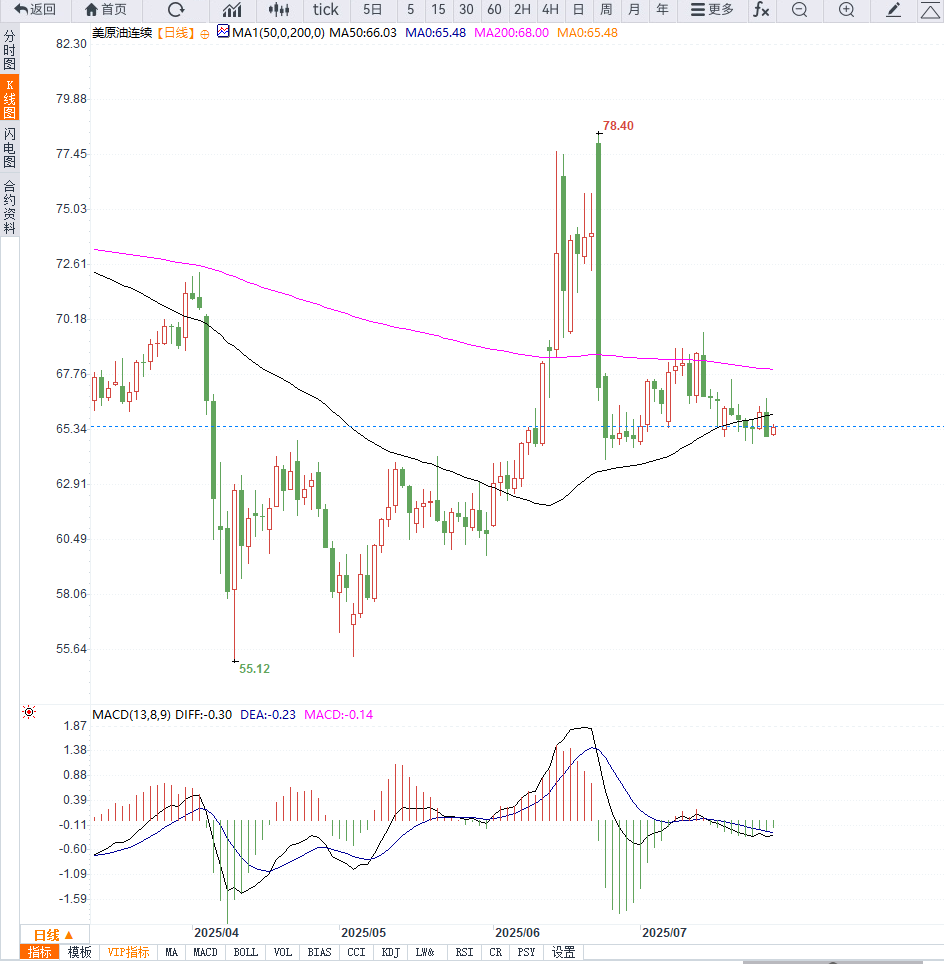Crude oil trading reminder: Global trade sentiment improves, oil prices rebound slightly, and the medium-term trend remains volatile and downward
2025-07-28 09:30:00
The United States and the European Union reached a trade framework agreement on Sunday, proposing to impose a 15% import tariff on most EU goods, lower than the originally planned 30%, successfully avoiding potential larger-scale trade frictions.
According to market research, the agreement has injected some confidence into the global economy and eased concerns in the crude oil market about weak fuel demand. At the same time, the United States and Asian countries are also expected to extend the current tariff suspension agreement, further boosting investor confidence.
“The possibility of a U.S.-EU deal and a trade easing between the U.S. and China is supporting global financial markets and energy prices,” said Tony Sycamore, market analyst at IG.

WTI crude oil rose slightly, but still constrained by supply concerns
On Monday morning, U.S. crude oil futures rose 22 cents to $65.38 per barrel, while Brent crude oil rose slightly to $68.66 per barrel. Although oil prices rebounded, they had fallen to a three-week low in the previous period, and the market is still digesting the impact of Venezuela's potential increase in supply.
It is reported that Venezuela's state-owned oil company PDVSA is preparing to resume operations with foreign joint ventures. Once US President Trump restores the corresponding export authorization, the country will be able to export crude oil again in a swap manner, which may bring additional supply pressure to the market.
OPEC+ will meet to assess the market, but is expected to maintain existing production increase plan
OPEC+'s market monitoring committee will hold a meeting on Monday. According to four representatives, it is expected that no adjustment will be made to the current production increase plan of the eight member countries. According to the current arrangement, the group will increase production by 548,000 barrels per day from August to match the trend of rising demand in summer. Nevertheless, the controllability of the production increase rhythm is still closely watched by the market.
An OPEC+ representative pointed out: “The current market’s ability to absorb new supply is still strong, and OPEC+ hopes to gradually recover the market share lost during the epidemic.”
Geopolitical tensions in the Middle East have re-emerged, providing safe-haven support
On the other hand, the Houthi armed forces announced on Sunday that they would attack all shipping companies that do business with Israel, regardless of their nationality. This statement has exacerbated geopolitical tensions in the Middle East, which may affect the security of key shipping routes and increase the risks of crude oil transportation, thus providing bottom support for oil prices.
According to JP Morgan analysis, global crude oil demand increased by 600,000 barrels per day in July, but global inventories also increased, with an average increase of 1.6 million barrels per day, reflecting the uncertainty of the supply and demand balance. This situation may limit the continued upward momentum of oil prices in the short term.
Judging from the daily chart of U.S. crude oil (WTI), the price has rebounded after receiving support near $64.80 last week, and is currently approaching the previous intensive trading resistance area of $65.50 to $66.20.
The MACD indicator initially formed a golden cross below the zero axis, indicating that the short-term bullish momentum has increased; the RSI also rebounded above 50, indicating that market sentiment has gradually improved. But at the same time, oil prices are still subject to the suppression of the downward trend line. If it fails to effectively break through $66.50, the rebound may be blocked again.
If it falls back, the 60-day moving average (currently around $64.00) will become an important support. Overall, oil prices will fluctuate strongly in the short term, but a trend breakthrough still requires further support from fundamentals.

Editor's opinion:
At present, the price of US crude oil is struggling to find a direction in the game between long and short positions. The positive trade situation has boosted market sentiment in the short term, while the geopolitical tensions in the Middle East have also provided some support. But on the other hand, the expectation that OPEC+ will continue to increase production and Venezuela may return to the export market has suppressed the supply side.
Overall, it is more likely that oil prices will trade between $65 and $68, and we need to pay attention to the actual results of this week's OPEC+ meeting.
- Risk Warning and Disclaimer
- The market involves risk, and trading may not be suitable for all investors. This article is for reference only and does not constitute personal investment advice, nor does it take into account certain users’ specific investment objectives, financial situation, or other needs. Any investment decisions made based on this information are at your own risk.





















